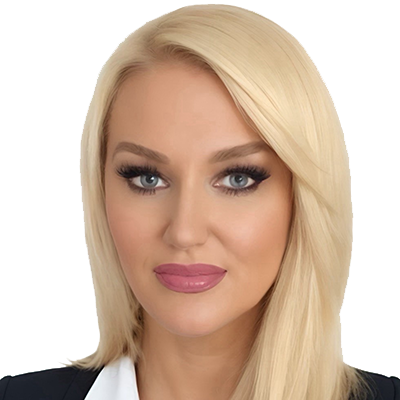Police Criminal Behaviour
https://www.inltv.co.uk/index.php/policecriminalbehaviour
"The Truth Is Important" ... Michael Drury
Shot former drug squad detective Michael Drury opens up on Roger Rogerson
Walk The Line Between Crooked Cops And Criminals
with Benoit Roberge - The Fifth Estate
Neddy Smith -One Of Australia's Most Dangerous Criminals Exposes Police Corruption
60 Minutes
Neddy Smith Dies In Long Bay Jail aged 76 Part 1
Neddy
By: Neddy Smith; Tom Noble
- Publisher: Kerr Publishing
-
Print ISBN: 9781925282924, 1925282929
Print ISBN: 9781925282924, 1925282929
-
eText ISBN: 9781925282924, 1925282929
eText ISBN: 9781925282924, 1925282929
- Format: Reflowable
- Available from﷼ 34.48 SAR
SKU:9781925282924 - Subject: Biography & Autobiography, Criminals & Outlaws
Born: Arthur Stanley Smith
Criminal career Smith spent much of the rest of his life in prison, serving sentences from 1963 to 1965, 1968 to 1975, 1978 to 1980, and 1989 until his death. Smith was a self-confessed heroin dealer, and armed robber, who gained notoriety for his violent temper.
Arthur Stanley "Neddy" Smith (27 November 1944 – 8 September 2021) was an Australian criminal who was convicted of drug trafficking, theft, rape, armed robbery, and murder.
Smith served a life sentence since 1989 and was imprisoned in Lithgow Correctional Centre after he was moved from Long Bay Correctional Centre, New South Wales, where he spent 14 years. Smith's bodyguard, Graham "Abo" Henry, claimed in ABO — A Treacherous Life: The Graham Henry Story that the gang of criminals led by Smith committed crimes worth A$25 million in the 1980s.
Arthur Stanley Smith "Neddy Smith" is scandalous
as a famous hoodlum and furthermore for his criminal demonstrations records.
Arthur Stanley Smith
Born: 27 November 1944 in Australia
Died: 8 September 2021 (aged 76) in Malabar, New South Wales, Australia
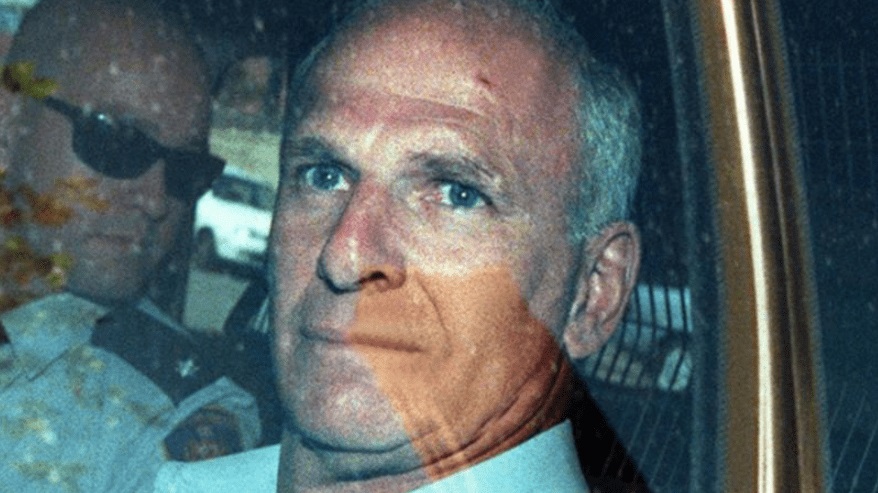
Neddy Smith Sydney's Most Famous Crime Boss - Introduction
The Full Video can be viewed further down this INLtv.co.uk web page
Neddy Smith Died In an Aged Care Unit In Long Bay Jail
Neddy Smith Dies In Long Bay Jail At 76 Years Of Age Part 2
From the greater part of the marked destinations, Neddy Smith’s reason for death is noted as normal causes. Also, he died at 76 years old in Long Bay Jail Hospital.
Neddy Smith had been experiencing a sickness called Parkinson illness. This had driven him to take the assistance of a mobile casing for his day by day exercises.
From the greater part of the marked destinations, Neddy Smith’s reason for death is noted as normal causes. Also, he died at 76 years old in Long Bay Jail Hospital.
Neddy Smith whenever had professed to have a total assets in millions and surprisingly more.
Indeed, his precise all out income have not yet been investigated, yet we found that he had carried on with an exclusive requirement life in his life while he was out of prison before.
Did Neddy Smith Help Roger Rogerson Get Away With The Shooting Of Warren Lanfranchi?
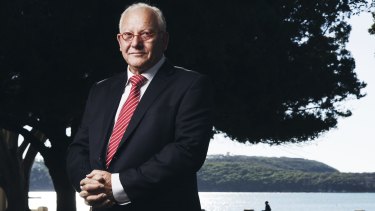
Former police officer Michael Drury. Roger Rogerson was charged with conspiracy to murder Drury but found not guilty.
Perth Mint Swindle
Crooked Cop's Confession About Australia's Biggest Gold Swindle 60 Minutes
The Perth Mint Swindle
http://www.inlnews.com/PerthMintSwindleTheMovie.html
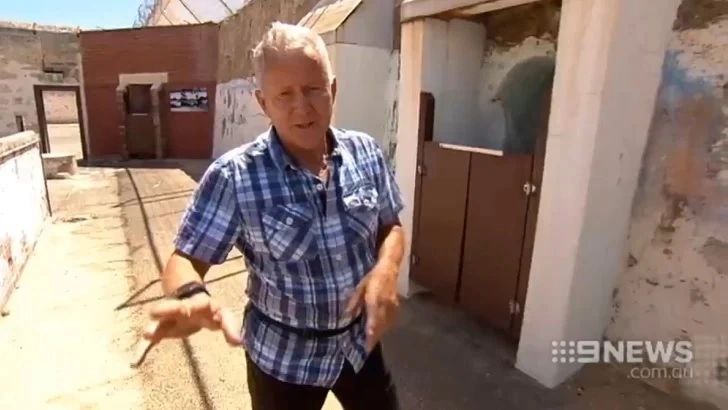
Ray Mickelberg at Fremantle Prison, describing the area where his finger was bitten off completely.
The person who was the first person to be accused by former Detective Don Hancock of being the mastermind behind the Perth Mint Swindle, before the Mickelberg Brothers were arrested for the Perth Mont Swindle, personally witnessed Ray Mickelberg's finger being bitten off by FRemantle Prison prisoner Gary Smith, in the 2 Division Yard of Fremantle Prison The witness of the loss of Ray Mickelberg's finger was serving a three year prison sentence on a false trumped up fraud charges, having being framed and set up by now retired Superintendent Roald Leslie Carey, who Mr White, a fellow Fremantle Prisoner, stated was one of the most powerful corrupt police officers in Western Australia in the 1980's, who was in the same corruption and power level as former Detective Roger Rogerson.
All is revealed in the new book being published and film being made called
The Dark Secrets in the History of Perth, Western Australia (The Untold Story).
Prisoner Gary Smith, who was speaking to the witness of the loss of Ray Mickelberg's finger the week before Ray Mickelberg's finder was bitten off, stated that Gary Smith was due to do to court that week for over 30 breaking an entering charges. Gary Smith was never charged for biting off Ray Mickelberg's finger and flushing the end of Ray Mickelberg's finger down the toilet. It is understood that Gary Smith's reward payment for doing the favour for Detective Don Hancock, was that Detective Don Hancock arranged for Gary Smith to receive probation for his over 30 breaking and entering charges, instead of a long prison sentence, which Gary Smith should have received for such charges.
To view the full Perth Mint Swindle please go to
https://inltv.co.uk/index.php/great-perth-mint-swindle
The Perth Mint Swindle is the popular name for the robbery of 49 gold bars weighing 68 kg from the Perth Mint in Western Australia on 22 June, 1982. The bullion was valued at A$653,000 at that time (2011:$2.02 million). As of 8 January 2018, the value of the 68 kilograms of gold would approach AUD $3.7 Million.
According to police at the time, three brothers, Ray, Peter and Brian Mickelberg, orchestrated the robbery. The three went to trial and were found guilty of the conspiracy and sentenced in 1983 to twenty, sixteen and twelve years in jail respectively.
All three convictions were overturned in 2004. To date the case remains unsolved and continues to be fought by the Mickelbergs who maintain their innocence and allege a conspiracy by the Western Australia Police to frame them.
Note: Some Information on the Perth Mint Swindle not mentioned in Wikipedia
The Late and former Detective-Sergeant Don Hancock, who was later promoted to head of the State Criminal Investigation Bureau (CIB)
came around to a person's apartment in Perth ( before the police tried to frame the Mickelbergs) at 6 am a few days after the 22nd June, 1982 with two car loads of detectives, to search this person's house and take him away to try and frame him for the Perth Mint Swindle. Because it seemed that it would be too difficult to frame this person for the Perth Mint Swindle, the WA Police headed by Late and former Detective-Sergeant Don Hancock, decided that the Mickelberg brothers were easier to frame for the Perth Mint Swindle, for a number of reasons. The full story is being published in a new book called..
The Dark Secrets in the History of Perth, Western Australia (The Untold Story).
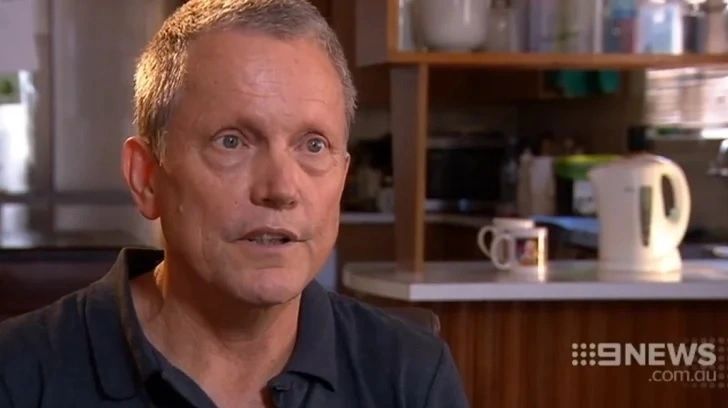
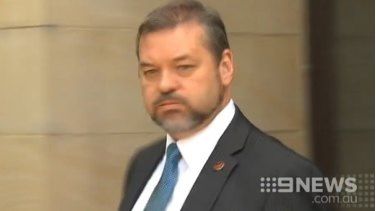

Peter and Ray Mickelberg exit court after another battle
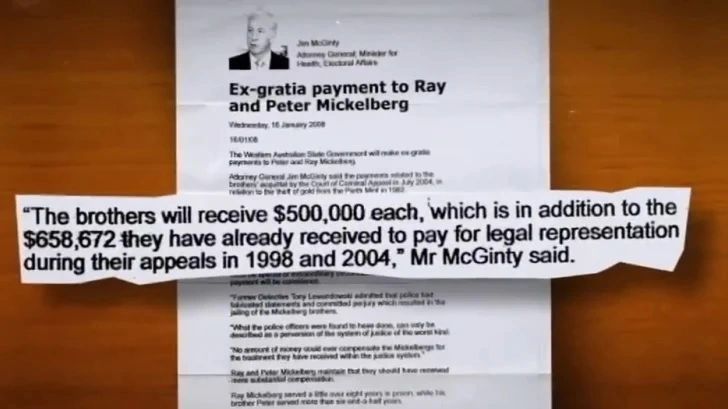
The ex gratia deal that stipulated the State pay for the Mickelbergs' Legal Aid was mentioned in this 2008 press release from Attorney General Jim McGinty.
Mickelberg Brothers
Soon after the robbery police investigations focused on the Mickelberg brothers. According to the police, the brothers stole cheques from a Perth building society and then fooled the mint into accepting those cheques in exchange for gold bullion which, it was alleged, the brothers had a courier pick up. The gold was picked up by a security company who delivered it to an office in Perth and then to Jandakot Airport, from where it seemingly disappeared.
In a separate matter, in September 1982, the three brothers, their parents and another man Brian Pozzi were charged over a matter relating to a manufactured gold nugget known as the "Yellow Rose of Texas". Perth Businessman Alan Bond had purchased the nugget for $350,000 in November 1980. It was later found to be worth less than $150,000 and Raymond Mickelberg and Brian Pozzi pleaded guilty to charges of conspiracy to fraud at their June 1984 trial.
After serving nine months of his jail term and having his conviction overturned on appeal, Brian was released from jail but died in a light aircraft crash on 27 February 1986, when the twin-engined Aero Commander he was flying ran out of fuel near Canning Dam on the outskirts of Perth. Whilst in prison, Ray and Peter embarked on a series of seven appeals against their convictions, essentially on the grounds that their confessions had been fabricated by police investigators. Ray and Peter served eight and six years of their sentences respectively before being released on parole.
In 1989, 55 kg of gold pellets, said to have been from the swindle, were found outside the gates of TVW-7 (currently Channel Seven Perth), a Perth television station, with an anonymous note addressed to one of the station's reporters—Alison Fan—protesting the Mickelberg's innocence and claiming that a prominent Perth businessman was behind the swindle
Police Officers
Don Hancock
The senior investigating officer in the case was Detective-Sergeant Don Hancock who was later promoted to head of the State Criminal Investigation Bureau (CIB). Hancock and a friend, Lou Lewis, died in a bomb explosion outside Hancock's home in Lathlain in September 2001. Hancock was murdered by Gypsy Joker Sid Reid in revenge for the murder of Billy Grierson, allegedly by Hancock after Grierson "made obscene comments in front of his daughter." A subsequent (2003) prosecution of an alleged accomplice was unsuccessful.
At the 2006 inquest into the October 2000 shooting death Billy Grierson, the coroner stated: "There is a significant body of evidence which suggests Mr Hancock may have been the shooter," but the Gypsy Jokers "could have a large number of enemies." he was unable to determine who Grierson's killer was because Hancock was now dead, police had failed to conduct routine forensic science tests and had failed to search Hancock's home. The relevant senior investigating officer was Kim Gage, head of Kalgoorlie detectives, who had reportedly spent the day drinking with Hancock and others. Reid was convicted of the murder and sentenced to life in jail which was reduced to 15 years for helping police in the failed second prosecution.
Tony Lewandowski
In 2002, midway through a State Royal Commission into police corruption, a retired police officer, Tony Lewandowski, who had been at the centre of the case, made a confession of his involvement in fabricating evidence which was used to help frame the brothers. Lewandowski's senior officer during the investigation was Don Hancock. The two were the only people present at the brothers' interviews following the Mickelberg arrests.
"(On that day), Don Hancock came into the room and told me to make Peter strip naked. Don then went up to Peter and gave him two or three quick punches in the solar plexus. The statements purportedly taken from Peter Mickelberg on July 26, 1982, were in fact not taken in Peter's presence that day, but were a fabrication made by Don Hancock and myself shortly after September 2, 1982. I gave evidence at the trial and numerous appeals. All that evidence in relation to the so-called confessions was false." —Statement of Tony Lewandowski
Lewandowski was subsequently charged with attempting to pervert the course of justice, making false statements, fabricating evidence and perjury. In May 2004, just before facing trial, Lewandowski apparently committed suicide, but there has been some speculation as to whether or not that may have been staged to cover his murder. Although now dead, Lewandowski's confession directly implicated Hancock in fabricating evidence in the Mickelberg case.
Convictions Quashed
In July 2004 the Western Australian Court of Criminal Appeal quashed the brothers' convictions after seven unsuccessful attempts. The judge ruled that with the suppression of their sentence, they were entitled to a presumption of innocence. The Assistant Police Commissioner, Mel Hay, expressed disappointment with the decision which prompted a threat of a defamation lawsuit from the brothers. The brothers subsequently sued the Western Australian government for libel, and as part of the settlement, the West Australian police issued a public apology in December 2007.[10]
After lodging claims for compensation, in January 2008 State Attorney-General Jim McGinty offered $500,000 in ex-gratia payments to each brother for the "injustice done to them". The payment followed $658,672 paid to cover legal costs of their two appeals. The Mickelbergs' lawyer had asked for $950,000 in compensation for Ray and $750,000 for Peter.
Books on the Case
Author Avon Lovell wrote a book about the case in 1985: The Mickelberg Stitch, which alleged questionable investigation practices by the police, including production of unsigned confessions and a forged fingerprint. The police union collected a levy of $1 per week from each member to fund legal action against Lovell and his publishers and distributors to suppress publication of the book. It was estimated that between one and two million dollars was raised. The book was banned by the State Government, but was still freely available to be read at the J S Battye Library. The ban was eventually lifted.
A second book by Lovell, Split Image, was published in 1990 and met a similar fate to the first. This ban was also lifted later.
In March 2011, Lovell launched a third book on the case, Litany of Lies, at about the same time that Antonio Buti wrote on the subject.
In Popular Culture
Two telemovies based on the swindle have been made.
- The Great Gold Swindle (1984), directed by John Power and written by David White; featuring John Hargreaves (Ray Mickelberg), Tony Rickards (Peter Mickelberg), Robert Hughes (Brian Mickelberg), Bryan Marshall (Hancock), Chris Haywood (Peter Duvnjak), Steve Jodrell (Chris Hunt), Robert Faggetter (Det. Sgt. Hooft) and Bill McCluskey (Terence Henry). This version was also broadcast in Brazil, under the title A Grande Fraude, and was released on video in France as Les mercenaires de l'or.
- The Great Mint Swindle (2012), directed by Geoff Bennett, written by Reg Cribb and Paul Bennett; featuring Grant Bowler(Ray Mickelberg), Todd Lasance (Peter Mickelberg), Josh Quong Tart (Brian Mickelberg), Shane Bourne (Hancock), John Batchelor (Lewandowski), Maya Stange (Sheryl Mickelberg) which aired on 11 March 2012.

- The Peter Mickelberg and the Media chase former Detective Don Hancock after one of Ray and Peter Mickelberg's Supreme Court Appeals
- Former Detective Don Hancock who masterminded the setting up and framing the Micklelberg Brothers for the Perth Mint Swindle, and was accused of shooting a bike in the Kalgoorlie Goldfields., and accused at the Shirly Finn Inquest as being of one of the people who shot brothel madam Shirly Finn at the South Perth Gold Course in the front seat of her own car. Don Hancock's car was blown up by a bomb thought to have been planted by a bikie gang as a pay back for the murder f a fellow bike by Don Hancock.
"Roger Rogerson Former Australian Police Officer Is An Evil Man"... -60 Minutes
Good Cop Bad Cop -Roger Rogerson 60 Minutes Part 1
Police Reveal Details Of The Underbelly Killings Of Police Informer Terry Hobson And His Wife (2015) Four Corners
The Life and Death of Sally-Anne Huckstep
The life and death of Sallie-Anne Huckstepp
THE Sydney prostitute thought going public about crooked cops involved in killing her partner would protect her. She was wrong.
SALLIE-Anne Huckstepp was a Sydney prostitute who bravely, and perhaps naively, blew the whistle on crooked cops — but it was a move that ultimately cost her life.
Huckstepp, 26, was found floating in Sydney’s Busby Pond, Centennial Park, on February 7, 1986 by a man walking his dog.
No one has ever been convicted of her murder despite it resulting in one of the longest running inquests of its kind in Australia, from 1987 to 1991.
But many believe they know who was responsible — former NSW detective Roger Rogerson, who was convicted over the murder of Jamie Gao yesterday, and former underworld kingpin Arthur “Neddy” Smith, who is serving two life sentences for another two murders but was acquitted of murdering Huckstepp.
In the early-mid 1980s, Rogerson was considered a star in the New South Wales police force and was earmarked as a potential future police commissioner. Smith, a violent gangster, was not yet as well-known or notorious as he would go on to be.
At the time of her death, Huckstepp had become a threat to Rogerson and Smith as she sought to make public the corrupt relationship between the pair, which was not yet widely known.

The former heroin addict was the girlfriend of heroin dealer Warren Lanfranchi, who worked with Smith, and was shot dead by Rogerson in Chippendale in 1981.
Rogerson claimed self-defence and was eventually given a bravery award.
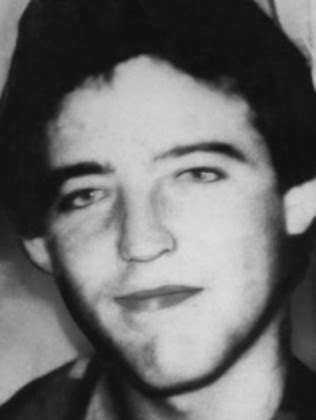
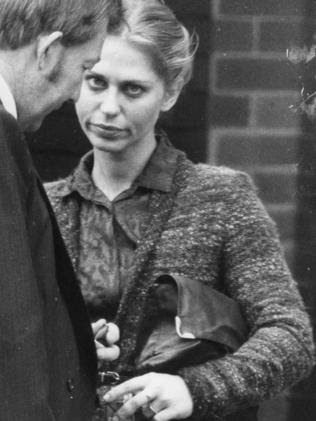
Huckstepp maintained Lafranchi had been murdered and she became a police informant.
Forty-nine days after Lanfranchi was shot, Huckstepp, her father Jack Krivoshow and a lawyer walked in to police headquarters on College St and detailed a string of allegations against NSW police — including verballing, bribery and the cold blooded execution of her boyfriend.
Huckstepp sought refuge and protection by pursuing the matter in the media.
She believed going public with the information would offer her protection from those who already knew she knew too much. It would be harder to hurt her and get away with it if the world knew who was after her and why.
She appeared in a sensational TV interview on 60 Minutes and made bombshell allegations about the corrupt relationship between Rogerson and Smith.
Huckstepp said Lanfranchi was meeting Rogerson to pay off $10,000 when he was shot. She said he’d left his gun at home and was unarmed.
Rogerson denied the allegations but a seed had been planted and suspicions grew.
In the years that followed, Huckstepp continued to publicly state on television and in courts that Lanfranchi had been murdered, until she was silenced for good.
On February 6, 1986 a person, who identified himself as Warren, called Huckstepp just before 11pm and asked her to meet him.
The next day she was found dead.
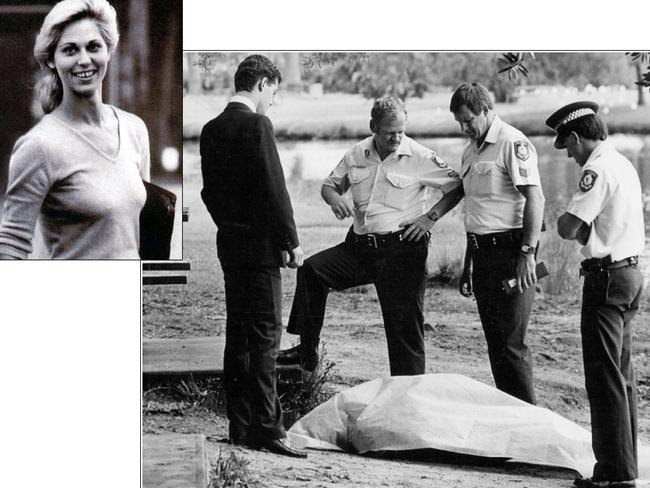
There appeared to be no attempt by the killer(s) to hide Huckstepp’s body which was found floating in a shallow pond in the heart of Sydney’s Centennial Park.
In a letter written in the weeks before her death, Huckstepp asked her estranged husband to look after the couple’s daughter “if things somehow go wrong”.
A drug associate of Huckstepp’s, who claimed to have met her on February 6, said she had been concerned about a looming meeting with “Wazza”, her heroin supplier Warren Richards, and “Rogerson”.
It was revealed days after her murder that Huckstepp had been strangled to death.
Years later Smith confessed to the murder when he told a cell mate he had strangled Huckstepp and held her underwater.
His confession was caught on secret police tapes and resulted in Huckstepp’s body being exhumed from Rookwood Cemetery for DNA testing.
Smith was charged with Huckstepp’s murder, eventually tried and acquitted.
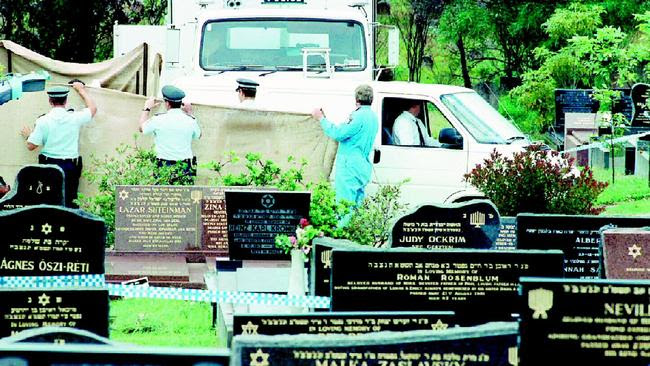
Rogerson had an alibi — he was drinking at a club in Merrylands with police prosecutor Mal Spence — but it’s widely believed he ordered Neddy to kill Huckstepp. Richards and other police officers were also persons of interest earlier in the investigation.
“You can bet your bottom dollar Roger and Neddy were behind her murder,” a police officer has said, The Daily Telegraph reported.
Sallie Anne’s daughter Sascha Huckstepp was just 12 years old when her mother was murdered.
She told 60 Minutes in an episode aired this week that Rogerson “shattered” her life.
“He stole my mother from me, he stole my adolescence. I see somebody who thought he had his own green light to do whatever he wanted to do and behave however he wanted to behave and damned be anybody who got in his way,” Sascha said.
“I believe that Rogerson had had enough, that he said that she had to go.
“He wanted her dead, he was being groomed for bigger and greater things and I think that was a big part of his anger and resentment towards my mother.”
Huckstepp believes Rogerson went to his “go-to man, his green light boy” Neddy Smith.
Even as a 12-year-old, Huckstepp didn’t believe initial suggestions her mother had died of a heroin overdose.
“She lived 10 minutes away (from the park). She wouldn’t be using drugs in a dark park sitting in blackness. There’s no need,” she said. “My first thought was Rogerson. Because I knew she had completely shattered his world and his career.”
She added: “There’s a small bone in the back of your throat called a hyoid bone, and that had been sort of crushed or fractured. It had been displaced, which indicates strangulation.”
Decades later, Rogerson finally found himself in a case he couldn’t dodge. On Wednesday, he and Glen McNamara were found guilty of murdering 20-year-old university student Jamie Gao.
And Sascha Huckstepp was just one person happy to see him fall.
“I thought, ‘Well they finally got him.’ You can’t worm out of that — there’s CCTV footage. Three people go in two people come out. You can’t deny that.”
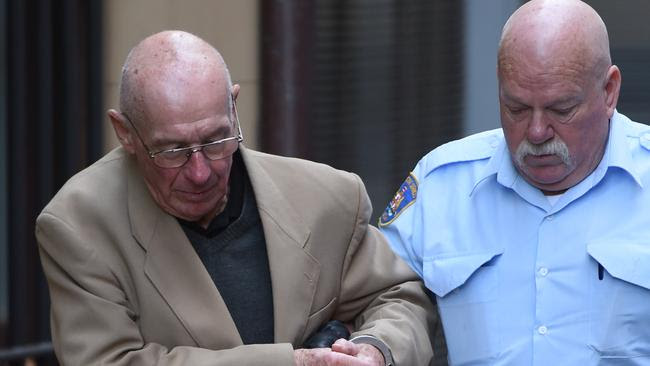
By Emma Partridge - https://www.smh.com.au/national/nsw/shot-former-drug-squad-detective-michael-drury-opens-up-on-roger-rogerson-20160531-gp84xu.html
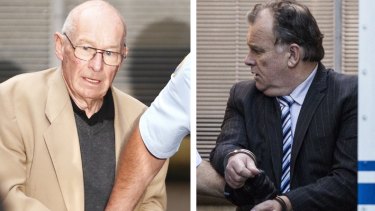
Roger Rogerson (left) and Glen McNamara during their trial for the murder of Jamie Gao during an "inept" drug rip-off.
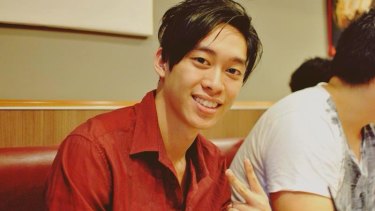
Victim: Jamie Gao.
Roger Rogerson was once charged with, but later acquitted of, conspiracy to murder police officer Michael Drury. More than three decades later, Drury shares his thoughts on Rogerson and how the murder of Jamie Gao has opened old wounds.
Pamela Drury was breastfeeding her seven-month-old baby girl, when her husband staggered into their Chatswood living room, his shirt drenched in blood.
He asked her to ring triple zero and begged her to take their two little girls to the bedroom and to stay there no matter what.
Even though his vision was blurred by blood, Michael Drury says he can still remember his wife's face.
"You know what happened at the house that night; I'll never forget it, you know, and the look on my wife's face - what she saw was terrible," he said.
"All I wanted to do was give my little girls a kiss and a cuddle to stop them from crying before I went to hospital because I didn't know whether I'd ever see them again."
It was 6.10pm on June 6, 1984, when Drury was shot twice through his kitchen window.
When the undercover drug squad officer woke from a coma about 12 days later, it did not take him long to figure out who he believed was behind his attempted murder.
There was no doubt in his mind that another policeman was involved - Roger Rogerson.
After one of the highest profile court cases in Sydney's history, Rogerson was acquitted.
About 30 years later, it took Drury's breath away when he learnt that Rogerson had been charged with another serious crime - the murder of Gao, a university student.
"Never in my wildest expectation would I have ever believed that a police officer would have been involved in that type of conspiracy - it was beyond belief for me. For everyone," Drury told Fairfax Media in an exclusive interview while the Jamie Gao trial was under way.
In 1989, Rogerson was charged with conspiring with two criminals - Chris "Rent-a Kill" Flannery and Alan Williams - to murder Drury.
After one of the highest profile court cases in Sydney's history, Rogerson was acquitted.
About 30 years later, it took Drury's breath away when he learnt that Rogerson had been charged with another serious crime - the murder of Gao, a university student.
On Wednesday, a jury found Rogerson, 75, and his co-accused Glen McNamara, 57, guilty of the 20-year-old's murder and stealing the 2.78 kilograms of ice he had brought to sell them.
Towards the end of the trial, Drury spoke about the sadness that the case had dredged up for him.
"What saddens me greatly is that there is not one ounce of remorse that's been shown by Rogerson or McNamara for what they did to that boy," he said. "Not one ounce of remorse.
"It's the absence of the remorse that I really find so sad.
"What they did to that boy, it really is so disturbing, so disturbing."
Despite believing Rogerson orchestrated his attempted murder, Drury says he feels sorry for him and his family.
"No one in this world could hurt Roger Rogerson as much as Roger Rogerson has hurt himself," he said.
"There was a man who had the world at his feet with his vocation and he destroyed it all."
Reflecting on his own case, Drury talks about why he believed Rogerson was at the heart of his attempted assassination.
"I always gave Rogerson the benefit of the doubt in the early hours but, as time went on, and I'm talking about two days or three, it became so sinister and so true in my mind that he was totally involved," he said.
Drury was on what he thought was his deathbed when he told fellow police officers that he believed he had been shot because of the "Melbourne Job".
He had been working undercover on an operation targeting heroin supply, which was partly conducted in Victoria.
His work resulted in charges being laid against Willliams, a drug kingpin.
Williams would later testify in the NSW Supreme Court that he attempted to bribe Drury through Rogerson to get his charges dropped.
Williams claimed that, when the repeated attempts at bribery were unsuccessful, he agreed to pay Flannery and Rogerson $50,000 each to kill Drury.
"I knew 100 per cent it was the Melbourne Job," Drury said.
"I knew that Rogerson knew Alan Williams, because he had fronted me about me trying to throw my evidence and I said, 'No, I rejected him.' "
When Williams went before the NSW Supreme Court more than 25 years ago, the indictment that was read to him said he "conspired with Christopher Flannery and Roger Rogerson to murder Michael Drury".
Upon hearing this, Williams informed the court that he was guilty of the charge - which carries a maximum sentence of life in prison.
It's late on a Thursday night and Drury sips on a coffee, and talks again about how sad he feels, reading about Rogerson's involvement in Gao's death.
"I find this an amazingly interesting case because I don't believe Roger Rogerson joined the cops as a bad person," Drury said.
"I give him credit and say he must have been a decent young man. But what went wrong and where did it go wrong to go from one extreme to the other
Roger Rogerson Former Australian Police Officer Was An Evil Man -60 Minutes
Sex Worker Hero Who Exposed The Dirtiest Australian Police
The French Connection Inside The New Mafias
Including The Georgian Russian Mafia who moved Their Operating Base
to Ukraine because The Georgian Authorities
were determined to arrest them all- Real Stories
https://en.wikipedia.org/wiki/Georgian_mafia
The Georgian Mafia Now Based In The Ukraine -
The French Connection
The Georgian Mafia
The Georgian Mafia (Georgian: ქართული მაფია, romanized: kartuli mapia) is regarded as one of the biggest, powerful and influential criminal networks in Europe, which has produced the biggest number of "thieves in law" in all former USSR countries and controls and regulates most of the Russian-speaking mafia groups. They are very active in Russia and Europe. The Georgian mafia has two major criminal clans from Tbilisi and Kutaisi. Georgia always had a disproportionately high number of crime bosses and still has a majority of the 700 or so still operating in the post-Soviet space and western Georgia (Kutaisi Clan) is particularly well represented.
In some of its rules or "laws", the Georgian mafia parallels the Sicilian Mafia. There are differences but many things are similar.
Ukrainian Mafi
https://en.wikipedia.org/wiki/Ukrainian_mafia
Ukrainian Mafia is a type of criminal organization with origins in Ukraine. Such organizations are regarded as one of the most influential types of organized crime coming out of the former USSR, including also the Russian mafia, the Georgian mafia, the Chechen mafia, the Armenian mafia and the Azerbaijani mafia. Ukrainian criminal organizations are involved in a significant number of illegal activities. Although Ukrainian criminal organizations are for the most part independently operating enterprises, they are sometimes connected with Russian mafia organizations, such as the case with Semyon Mogilevich.
Arthur Stanley Smith "Neddy Smith"

Born: 27 November 1944 in Australia
Died: 8 September 2021 (aged 76) in Malabar, New South Wales, Australia
Arthur Stanley Smith "Neddy Smith
Sydney's Most Famous Crime Boss Full Video
Arthur Stanley Smith "Neddy Smith" is scandalous as a famous hoodlum and furthermore for his criminal demonstrations records. Renowned by his public name ‘Neddy’, his complete name is observed to be Arthur Stanley.
Smith came down with the features after the terrible bug information on Neddy Smith began surfacing the net.
Neddy Smith’s better half Debra Smith never realized that her then-spouse was a street pharmacist.
The one who was hitched to the criminal for over 20 years and saw the great side and nature of Neddy, which individuals are really unconscious of.
Debra even communicated her desire to compose a book that incorporates the legit side of her ex. It’s not in the safeguard of her previous spouse, but rather to sharing time his untold and obscure stories.
After the genial separation among Neddy and Debra, the previous one consumed his excess time on earth alone in prison while the last one was answerable for dealing with kids and furthermore currently tracked down another adoration accomplice.
Neddy Smith shared four youngsters, one girl Jaime and two children with his ex Debra.
His oldest child’s name is observed to be Darrin Smith.
Despite the fact that Neddy is an individual occupied with criminal and unlawful demonstrations, his previous spouse depicts him as a caring dad who was exceptionally severe with regards to how the children ought to be raised.
Regularly marked as a pleasant family man, Smith utilized some unacceptable way to deal with satisfy and meet his monetary prerequisites.
Neddy Smith had been experiencing a sickness called Parkinson illness. This had driven him to take the assistance of a mobile casing for his day by day exercises.
From the greater part of the marked destinations, Neddy Smith’s reason for death is noted as normal causes. Also, he died at 76 years old in Long Bay Jail Hospital.
Blue Murder Early Series - Episode One Voice Only Version
Blue Murder Early Series - Episode One Video Version
Set in the 1970s and 1980s in Sydney, the miniseries concerns the relationship between controversial former detective Roger "the Dodger" Rogerson and notorious criminal Arthur "Neddy" Smith 1995
Blue Murder Killer Cop | Part 1 - A floating body, a drug deal gone wrong, and two former detectives the perpetrators. Life imprisonment is the end of Roger Rogerson's story. The last Blue Murder ended with his expulsion in disgrace from the NSW Police Force. In this installment, Rogerson struggles to make a living in a world that's rapidly changing, caught between the pressures of criminals, police and a love that might save him. 2017
Stars: Richard Roxburgh, Toni Collette, Matt Nable
Blue Murder Killer Cop Full Crime Drama Mini Series Part 2 Video
Blue Murder Killer Cop Full Crime Drama Mini Series Part 2
Voice Only Version
Blue Murder Killer Cop Full Crime Drama Mini Series Part 3 Video
Blue Murder Killer Cop Full Crime Drama Mini Series Part 3
Voece Only Version
Former NSW Detective Roger Rogerson -Life And Times Part One
Former NSW Detective Roger Rogerson -Life And Times Part Two
Good Cop Bad Cop - Roger Rogerson 60 Minutes Part 1
Good Cop Bad Cop -Roger Rogerson 60 Minutes Part 2
Good Cop Bad Cop -Roger Rogerson 60 Minutes Part 3
Good Cop Bad Cop -Roger Rogerson 60 Minutes Part 4
Arthur 'Neddy' Smith: the dirty detective
By Michael Duffy and Bob Bottom
https://www.smh.com.au/national/arthur-neddy-smith-the-dirty-detective-20110617-1g79z.html
ARTHUR Smith was born in 1944 and grew into a major criminal, involved particularly in armed robbery, heroin trafficking and murder.
He became a Sydney celebrity because of his close relationship during the 1980s with controversial detective Roger Rogerson. It was the type of relationship that had often flourished before. Smith, like other successful criminals, survived by being a regular police informer. But in this case it attracted considerable publicity because the media and other institutions had started to take a keen interest in corruption.
A number of books and the acclaimed television drama series Blue Murder have been based on Smith, Rogerson and people they associated with, making this the most richly, if unevenly, documented period of organised crime in Sydney.
Smith was a big and very aggressive man and, in the mid 1970s, after serving time for rape and committing a number of armed robberies, he worked as a standover man for Murray Riley, who represented Australia in rowing at the 1952 and 1956 Olympics, winning a bronze medal in 1956. He became a distributor for heroin imported by Riley's syndicate, later setting up on his own with William Sinclair and Warren Fellows. Soon, he has claimed, he employed 10 dealers in Sydney's eastern suburbs and was turning over millions of dollars a year. His house in St Peters was turned into a fortress, with 2.5 metre walls, security doors and windows, and closed circuit television.
The most notorious point in the relationship with Rogerson occurred on June 27, 1981. Smith took a young heroin dealer, Warren Lanfranchi, to a meeting with Rogerson in Dangar Place, in inner city Chippendale, telling Lanfranchi he guaranteed his safety. Smith had met Lanfranchi in jail and the two had become friends. The reason Rogerson was so keen on a meeting that day, and why Lanfranchi felt obliged to attend, is still the subject of debate. One theory is that the violent Lanfranchi had been causing too much trouble: he had ripped off a heroin dealer who was under police protection and, on another occasion, pointed a gun at a police officer. According to this theory – denied by police – Lanfranchi hoped to make his peace with Rogerson, possibly through payment of a bribe.
On the day of his death, Lanfranchi was wearing a body shirt and tight trousers. Smith had made sure he did not wear a coat so it would be clear to police he was unarmed.
At the meeting, Rogerson shot Lanfranchi dead, later claiming this was done in self-defence because Lanfranchi had drawn a pistol.
The killing attracted considerable attention. The jury at the coronial inquest declined to say Rogerson had acted in self-defence. This was despite the fact the 18 police in the area when Lanfranchi was killed all supported Rogerson's version of events. Not one has ever suggested publicly there was anything amiss in their colleague's action, or implausible in the idea that Lanfranchi managed to smuggle a gun past Smith and then draw it against the well-armed detectives.
For years after the shooting, Lanfranchi's girlfriend, prostitute and heroin addict Sallie-Anne Huckstepp, claimed he had been murdered.
In 1986, Huckstepp, who had been making allegations about the corrupt relationship between Rogerson and Smith (which was not yet widely known), drowned in a shallow pond in Centennial Park. Smith was charged with her murder but acquitted. The case remains unsolved.
Smith later claimed that Rogerson and colleagues, as a reward for bringing Lanfranchi to the meeting in 1981, gave him a “green light” to commit crime. Police deny this.
In the mid-'80s Smith lost his regular source of supply and turned to armed robberies again, specialising in payrolls and making more than half a million dollars. He fell out with Rogerson, who was under pressure because of the relationship. In April 1986, he announced on television that Smith was a police informer. The next night, Smith was run down by a car in Waterloo.
Meanwhile, Rogerson was having his own problems. In June 1984, detective Michael Drury was shot through the window of his home. On what he thought was his deathbed, he claimed Rogerson had tried to bribe him to change the evidence he had been due to give at the drug trial of criminal Alan Williams. Drury had refused the offer and it later emerged that hitman Christopher Flannery had been hired to kill him, but he managed to survive.
Rogerson – who provided an alibi for Flannery at the time of the shooting – was charged with involvement in the attempted murder. He was dismissed from the police force for other reasons in 1986 and later acquitted of the murder charge.
One day in October 1987, Smith had a big drinking session with a group of people, including Rogerson. Towards evening, Smith and friend Glen Flack headed off alone and were involved in a collision with a tow truck. In the ensuing argument, Smith stabbed tow truck passenger Ronald Flavell, who died. The investigation stumbled when there was a break-in at the local police station and relevant documents were stolen but, in 1990, Smith was sentenced to life in prison for the murder.
In 1994 he boasted to a cellmate about having killed many people. The claims were secretly taped. Smith was charged with seven murders and tried for two – Sallie-Anne Huckstepp and brothel keeper Harvey Jones. He was acquitted of the former (as we have seen) and convicted and given a second life sentence for the latter. Smith is still alive and in prison, where Parkinson's diseases has confined him to a wheelchair for much of the time.
In his autobiography, Neddy, he wrote: “There has always been crime and corruption within the NSW police force but nothing like it was [in the 1980s] . . . I could never have committed any of the major crimes I did, and got away with them, without the assistance of the NSW police force. They were the best police force that money could buy – believe me, because I bought them hundreds of times.”
Rogerson returned to court several times, being convicted of involvement in drug dealing, which was overturned on appeal, and convicted and jailed on two occasions, once for perverting the course of justice in regard to using bank accounts in a false name, and once for lying to the Police Integrity Commission.
Nicola Gobbo -Melbourne Defence Lawyer Who Informed On Clients For The Police
Nicola Gobbo explains why she became Lawyer X and informed for police
As Nicola Gobbo made the frantic dash to a morning court appearance in August 2005, she had no idea she was about to upend her entire life and turn the justice system on its head.
"I can vividly remember thinking I just can't keep going, I can't do this anymore," Ms Gobbo told the ABC.
Even before she arrived at the courtroom, she had already crossed an ethical line.
That morning she had called a Victoria Police detective and confessed that her infamous client, drug boss Tony Mokbel, was pressuring her to take on that morning's case.
When she arrived at court, the case was postponed.
Instead, Ms Gobbo found detectives standing outside the courtroom. She saw them as a safe haven.
Amid tears, she unleashed her deepest fears and worries on the detectives. She told them her criminal clients were pressuring her to break the law.
The police saw a rare opportunity to infiltrate the underworld but it would mean doing something that had never been done in Australian history: signing up a criminal defence lawyer as an informer.
https://www.abc.net.au/news/2020-09-09/nicola-gobbo-why-she-became-lawyer-x/12618940
The events set in motion that day would eventually spark a royal commission into Victoria Police's use of informers and lead to Ms Gobbo living in hiding.
Already, one former client of Ms Gobbo's has been released from prison because a judge ruled her informing constituted a miscarriage of justice. Eight more former clients have appeals pending.
The royal commission heard that more than 1,000 people could be affected by her informing. It heard 124 cases may have been unfairly affected.
The story has been told in TV dramas, tabloid front pages and statements of evidence but it has never been fully told by the woman herself.
While in hiding, Ms Gobbo spent months talking to the ABC podcast Trace: The Informer, to explain for the first time why she fed the secrets of some of the most dangerous and violent criminals in the country to police, while acting as a defence barrister.
More than that, she revealed why — after years of working with the police — she stopped and why the separation has been so acrimonious.
Always an overachiever
In media reports, Ms Gobbo has sometimes been dubbed a "blue blood", which has served the tabloid narrative of a posh, high-flying lawyer who fell from grace.
It is true her uncle, Sir James Gobbo was a Supreme Court Judge and a Governor of Victoria but when Ms Gobbo's grandparents first arrived from Italy, they started out by opening a soup kitchen in Carlton.
Her father took it over at 17 years old and provided for the family.
"Sir James rose to where he did by reason of the hard work of my dad, but my dad never resented him for his success," Ms Gobbo said.
Ms Gobbo jokingly refers to her famous uncle as "Sir Arsehole" because, she claims, he had little to do with his nieces, and was largely estranged from her family.
Sir James declined to comment.
When Ms Gobbo was in primary school, her mother was diagnosed with non-Hodgkin's lymphoma. Nicola recalls her mother vomiting and crying, juggling night shifts at a hospital with fears of leaving her two young daughters behind.
Her mother survived cancer but her father would later develop the same condition and die while Ms Gobbo was in high school.
Ms Gobbo's loss of her father at a pivotal age affected her deeply and she said this would leave her with a lifelong craving for a certain type of male attention and approval.
She attended the prestigious Genazzano private girls high school and studied law at Melbourne University, but in Ms Gobbo's telling, these were the product of a fierce work ethic and a "type-A personality" rather than entitlement.
"I do something 150 per cent or don't do it at all," she told the Royal Commission into Management of Police Informants (RCMPI) last year.
Sharehouses, drug busts and Nicola Gobbo's first offer to assist police
The first time Ms Gobbo found herself on the wrong side of the law, she was studying it at Melbourne University.
She was charged with drug possession after a small amount of drugs were found in her room at her Carlton sharehouse. She had no conviction recorded.
It is something her first mentor in the law, Alex Lewenberg, did not worry about when he hired her at the criminal law firm he managed, shortly after she was admitted to practice in 1997.
Mr Lewenberg asked Ms Gobbo if she had told the Board of Examiners, when she applied to practice, which she had.
She had also told the board that she had been the one who tipped off police five days before the raid, having become suspicious about her boyfriend's activities.
"I thought no more about it," Mr Lewenberg later told the royal commission.
What Ms Gobbo did not tell Mr Lewenberg was that $80,000 worth of speed belonging to her boyfriend was found in the raid on her Carlton home. Her boyfriend was charged over the haul.
Later, after the relationship had broken down, she helped police organise an undercover sting to try to get her ex-boyfriend out of the house. The sting never went ahead as police saw the law student as an over-enthusiastic loose cannon.
But by the time she began practising law, she felt like she had found herself a new home at Mr Lewenberg's firm.
"[He] became like a second father to me," she told the ABC.
"There's definitely always been a level of insecurity where I'm concerned because of not having a dad."
Mr Lewenberg thought Ms Gobbo was highly intelligent and articulate but he also wasn't blind to his new charge's activities outside of work.
"About six months into Ms Gobbo's employment, I became concerned that she was socialising with clients of the firm and police," he wrote in his statement to the royal commission.
He warned her to stop and his young employee assured him she was behaving professionally.
But whispers about Ms Gobbo's social life would follow her throughout her legal career. Around Melbourne, she became highly recognisable and began attracting attention.
To Paul Dale, a detective who got close to Ms Gobbo, the lawyer was just plain good company.
"She was extroverted; long blonde hair, low-cut top, big breasts, very short miniskirts, loud, centre of attention," he told the ABC.
Meeting Carl Williams and Tony Mokbel
After about a year, Ms Gobbo left Mr Lewenberg's firm and became one of the youngest women to pass the bar in Victoria.
She started to attract big-name criminal clients like Melbourne gangland bosses Carl Williams and Tony Mokbel, representing them at bail hearings.
"Any high-profile or high-level drug trafficker they arrested either had my phone number in his phone at the time of the arrest or opted to ring me.
"Getting Tony Mokbel bail after two failed attempts and exposing corrupt police assisted in building that reputation," she said.
Others saw her reputation differently.
Former crown prosecutor Geoff Horgan QC handled most of the big murder trials during Melbourne's gangland years and often crossed paths with Ms Gobbo.
"She could be a bit annoying because she would be contesting (an application for) a DNA sample or something like that, you don't expect people seriously going to contest those sorts of applications," he said.
"My impression is that she liked to big note herself; to be the centre of attention."
Police investigating Ms Gobbo's gangland clients already believed she had started to cross ethical lines, according to Commander Stuart Bateson's evidence at the royal commission.
"There was a small group of criminal lawyers we believed were part of a criminal enterprise," Commander Bateson told the inquiry.
A gangland taskforce request for surveillance on Nicola Gobbo in 2003, tendered to the royal commission, revealed that police suspected at the time that the barrister was assisting her big-name clients in their drug trafficking activities and providing them with information about other criminals in relation to gangland murders.
Ms Gobbo denies those allegations and told the ABC she did not break the law.
"But a number of police over that period of time made disparaging remarks to my face and behind my back along the lines of, if they could eliminate me they would be happy to do so, presumably because I was so successful at getting people out of custody," she said.
At the height of Melbourne's gangland war, Nicola Gobbo collapsed
As Melbourne's gangland war of the 2000s intensified, the life of an underworld lawyer became a heavier weight to carry.
People were being shot dead in broad daylight, mostly in a tit-for-tat feud to try to seize control over Melbourne's illicit drug trade.
The murderous environment enveloped Ms Gobbo in 2004 after a hitman close to Carl Williams was charged with murder.
She told the ABC that Williams' crew didn't want the hitman to turn on Williams but this meant the crew wanted her to find a psychiatrist to rule that the hitman was insane.
"They were actively seeking that I pervert the course of justice and break the law by misrepresenting that accused and by stitching him up in a way that if he ever decided to give evidence, that his evidence would be worthless," she said.
She told the ABC she refused to follow her clients' request.
Ms Gobbo said that at this time Tony Mokbel was profiting by sending associates to her.
She claimed she later found out the drug baron would tell his associates that she charged more than she actually did.
"He was actually making a commission off the people that he was sending to me."
A lawyer for Mokbel, who is in maximum security prison, said his client declined to comment.
These were some of the stressors she was contending with when, in July 2004, Ms Gobbo had a stroke and collapsed at home.
It left her with debilitating pain.
"Pain so bad that I couldn't be bothered socialising; eating hurt and even talking hurt," she said.
"[I was] work obsessed so my level of self-care was zero. Over-achieving again, wanting to be a QC in record time."
Meeting her police handlers
Ms Gobbo had reached a point where she didn't know how to say no to her big-name clients, according to her testimony at the royal commission.
Significantly, she was also worried that police might believe she was on the wrong side of the law herself.
The royal commission has heard she was the target of a surveillance operation by gangland detectives, who suspected she was passing on messages between her clients.
Although it heard these suspicions, they were never proven.
"I was frightened of being put in a position where I would be charged because of exposure to the accused," Ms Gobbo said.
She insists she never did anything unlawful but was worried about the view detectives, who were closely monitoring telephone intercepts of her conversations, might form.tec
So partly to save herself, she started talking to Victoria Police.
After her outburst at the Melbourne Magistrates Court in 2005, the detectives she unloaded on passed her on to a secret police unit, set up to handle informers.
A meeting was set to be at a discreet, highly secretive location but instead Ms Gobbo found herself meeting police at a building adjacent to her client Tony Mokbel's apartment.
"I just thought this is, this is madness! Are these people for real?" Ms Gobbo told the ABC.
But instead of cancelling the meeting, she met two police 'handlers' to discuss becoming an informer.
This crucial relationship began with a lie.
One of the handlers, whom she was trusting with her life, assured her the meeting wasn't being recorded. But it was.
In the secret recording of the meeting played at the royal commission, Ms Gobbo said she was willing to work with police, against her own client Tony Mokbel.
"I'm here because I've had enough … and I don't know the way out," she told police.
"I'm nearly 33, what have I done with my life? I've had a stroke, I get up at six o'clock, go to work by seven, spend all day working, very rarely do I go anywhere or do anything … for what?"
"I know that if I was married or if I had some particular reason to race home every night, I would. But the rate I'm going, I'm gonna end up dead."
She joked with the handlers about needing a couple of bottles of red wine for the conversation, instead of the offered cup of tea.
'The only friends she had were criminals or cops'
Ms Gobbo was still handling her clients and court work, while secretly communicating and meeting with police, passing on huge volumes of information.
Victoria police filed more than 5,000 written reports from her information in four years and in a letter written to senior police in 2015, Ms Gobbo insisted her information helped Victoria police make nearly 400 arrests.
Her main police handler, a man known by the pseudonym Sandy White, came to know her very well.
"She was a very needy person … she didn't seem to have any social life, everything revolved around work," he told the royal commission.
"I do think her whole social needs were provided by serious criminals and then over time that transferred to the source handlers."
Another handler, known at the royal commission as "Officer Fox" said he believed talking to police filled a void in Ms Gobbo's life.
"Her only social circle was with very serious criminals in Victoria and Australia and we were the only ones outside that circle who probably had some kind of moral compass."
Ms Gobbo became increasingly dependent on her handlers, as the level of danger she lived with grew.
"They [handlers] would say I wanted to keep going but they kept moving the goalposts," she told the ABC.
She said she slept less and less, always wanting to be prepared for complicated conversations she was going to have, in her complex double life.
Ms Gobbo fiercely denied ever using illegal drugs with or without her clients.
"For the record, amphetamines and coke were not used as helpers — I still can make it through a night without sleep if I need to with the assistance of caffeine."
The people she was informing on inhabited a world where speaking to police was a death sentence and Ms Gobbo said she was aware of the stakes.
"I'm on multiple recordings saying to Victoria Police: 'If this comes out you will be answering questions at a royal commission and I'll be dead.'
"I used to regularly say: 'You'll have to say nice things at my eulogy, because I won't survive this.'"
She told the ABC that if she did become isolated and dependent on her Victoria police handlers, it was not a lifestyle she chose.
"Victoria Police … actively encouraged me to have no life except for assisting them. And if that meant being out at three o'clock in the morning to meet someone, they were all in favour of that, even at a time when they knew that I was in significant pain and under the care of a pain specialist."
Victoria Police said they would not comment on those allegations until the full royal commission report was released.
"As we have made clear, Victoria Police has absolute respect for the royal commission process and as such we will not be commenting further until the commissioner has had the opportunity to consider all the submissions made and provide her final report."
While she doesn't abdicate responsibility for her choices, Ms Gobbo said that her weakness was wanting approval and she claimed Victoria police used this.
"It's almost like they would challenge me, by saying, 'We don't really believe that' or 'Are you sure?'
"Knowing my personality, which is, 'Well if you give me a challenge I'd rise to it', they did manipulate me in that way because they knew me very well."
As the informer/police handler relationship developed, Ms Gobbo started to believe the people she had trusted with her life were using her.
She claimed her key handler, Sandy White, referred her to a psychologist, ostensibly for her wellbeing, but Ms Gobbo claimed the real motivation was that police wanted to find out what she was thinking.
"He said that it was an operational health and welfare issue, and that he needed to satisfy his bosses.
"Fundamentally, the problem was that she [a police psychologist] was reporting back to my handlers."
Sandy White told the royal commission he was genuinely worried about Ms Gobbo. She had lost 49 kilograms since she started working with the police.
"She was under a lot of stress, and that impacted on her physically … at times she would report she couldn't sleep and she was grinding her teeth," he told the royal commission.
Other officers detailed to the royal commission their impressions of how their formerly ebullient informer was declining, mentally and physically.
"Source described herself as clinically depressed and unemployed, advised source to call psych, very quiet, deadly quiet, bored, could not be bothered leaving couch," Officer Green, Informer Contact Report — 22/1/07
"Suicide and depression brought up, admits has been suicidal twice," Officer Wolf, Informer Contact Report— 4/8/08
"She spoke to a doctor about dreams of killing herself, nausea, paranoid with fear, using too much morphine, 120mgs yesterday," Officer Smith, Informer Contact Report — 28/11/08
The murders that really started it all
By 2009, Ms Gobbo had stopped informing and her relationship with Victoria Police was completely acrimonious.
She was in poor health and claimed she had been forced into being a witness in a murder trial of two men accused of killing a police informer.
The royal commission heard that in 2008, Ms Gobbo wore a recording device to try to gather evidence for police against her former lover, drug squad detective Paul Dale.
Lawyers assisting the royal commission outlined details of the police case in their submissions to the commission which were made public last week. Terence Hodson, a client of Ms Gobbo's, had been about to give evidence against Mr Dale and another detective over a burglary of a drug stash house in 2003.
Before Mr Hodson could testify, the middle-aged carpenter-turned-drug dealer and his wife Christine were found shot dead, execution style, inside their living room in the Melbourne suburb of Kew.
The police case that followed was described at the royal commission as the most significant murder investigation in Victoria's history.
It has taken 16 years for the multiple links between Ms Gobbo and the infamous Hodson case to emerge.
Counsel assisting the commission's submissions said Paul Dale was a police suspect, as were Carl Williams and Tony Mokbel. Submissions said police later dismissed Mokbel from being involved.
Submissions from counsel assisting the royal commission said that in the weeks before the Hodson murders, Ms Gobbo put Paul Dale in touch with her gangland client Williams.
The submissions from counsel assisting the royal commission said that police had a belief Ms Gobbo "may have been [a] conduit between … Williams and Dale re IR [the police information report identifying Hodson as an informer]. Leading to killing of Hodsons".
The submissions said Williams told police Mr Dale asked him to arrange the murder of Mr Hodson, although this was just one of many leads police pursued, none of which were proven.
Mr Dale has categorically denied any involvement in or knowledge of the Hodson murders and claims he was set up. Williams was a proven liar with reasons to make it up, according to Mr Dale.
In a submission to the royal commission, Mr Dale said he had suffered for years "screaming under water" working against "powerful institutions" who sought to hide Ms Gobbo's role as a secret informer.
Did guilt drive Nicola Gobbo to become a police informer?
Through the steady release of never-before-seen documents tendered to the royal commission, including police reports, videos, secretly recorded phone calls, it's emerged police believed the Hodson murders may have been a factor in Ms Gobbo's journey to becoming a police informer.
Police officers have told the royal commission they suspected Ms Gobbo was somehow indirectly involved in the murders of Terrence and Christine Hodson.
In statements to the royal commission, four of the police handlers who worked most closely with Ms Gobbo have speculated she might have felt guilty about the Hodson murders and this might have motivated her to become a police informer.
"It became apparent over time that she had maybe unwittingly assisted with the passing of information, phones and/or documents between parties that ultimately led to the Hodson murders," Officer Fox wrote in his statement.
Sandy White told the royal commission: "Maybe she felt guilty about that [the Hodsons] and felt she had to do some good, it did cross our minds down the track."
Former gangland taskforce head Gavan Ryan told the commissioner in a closed court session: "My hunch is she knew something was going to happen then, that's my hunch, my theory. And she regretted not doing something and decided to roll over."
Police suspicions of Ms Gobbo's guilt were never proven
She became a registered police informer in 2005, one year after the Hodsons were killed.
In submissions from lawyers assisting the royal commission, Ms Gobbo said she had no knowledge of a plan to murder the Hodsons.
But during her evidence, Ms Gobbo admitted her behaviour as a lawyer was inappropriate and improper.
Counsel assisting submissions said that behaviour included acting for almost everyone involved in the drug house burglary, at the same time as she was meeting up with Mr Dale to discuss the case.
"What put me on the path that I ended up on in 2005 [becoming an informer] is because of being so, so far off the right track and out of my depth and out of control in 2004," she told the royal commission.
The two daughters of Terence Hodson, Nikki Komiazyk and Mandy Hodson, met with Ms Gobbo before the 2014 coronial inquest into their parents' death.
She offered to help find them legal representation and introduced them to her former boss, Alex Lewenberg.
Ms Komiazyk said she felt uncomfortable with Ms Gobbo's desire to assist her family from the start and now feels betrayed, as the royal commission has revealed more about Ms Gobbo's behaviour.
"Very much so, yes, because I can't understand why she wanted us to pursue the coroners [inquest] for Mum and Dad … it doesn't make any sense," she said.
After life as a secret police informer, Nicola Gobbo became a regular suburban mum
Nicola Gobbo sued Victoria Police in 2010 for failing to protect her as a witness.
The police agreed to a secret settlement, reportedly almost $3 million.
Then Ms Gobbo disappeared from legal and public life almost entirely and made a life for herself in Bayside, Melbourne.
She had two children in quick succession, a girl and a boy, and threw herself into life as a full-time mother.
She received a Volunteer's award at Government House for her work at a Brighton kindergarten.
But word of her past life was seeping out.
The Herald Sun newspaper ran a series of front-page articles about an unnamed lawyer who was a police informer.
Ms Gobbo's identity was kept secret after a desperate and costly legal fight by Victoria Police and instead she was known only as Lawyer X.
But some in the underworld knew just who that was and she received death threats.
Eventually, five years after the public heard about Lawyer X, the High Court would lift the suppression order on naming her and Ms Gobbo was forced to leave her newfound community.
She said Victoria Police convinced her to leave Australia before the start of the royal commission, for her safety.
Sometime after she fled the country, the ABC made contact with Ms Gobbo and she eventually decided to tell her story.
She told the ABC she was living in fear of corrupt police finding out her location, particularly as she claimed a police officer tipped the Herald Sun off to her informer role.
"Whomever it was who leaked the information to the Herald Sun and Weekly Times in early 2014 is a high-ranking copper who would have to be worried by now. And he could potentially know where I am. I fear that possibility and the stark reality that if something happened to me, nobody would know," she said.
She wanted to return to Australia but said police were threatening to take steps to remove her children from her care if she did, as their safety would be at risk due to Ms Gobbo's notoriety.
The ABC has seen an email from Victoria Police stating that "VicPol would notify [authorities] if the client comes back to Australia".
Ms Gobbo said she was stuck in a stateless limbo.
"My life each day when I wake up actually feels surreal. Like a bad movie. Like WTF am I doing in another country with two poor little kids?" she wrote in a text message to the ABC's Josie Taylor.
"I will never come up with sufficient words to express how angry and disgusted and revolted I am by those surly 'we know what's best' bullies."
She was furious at police for, as she put it, leaving her in a foreign country with no support or protection.
She sent the ABC the last text messages police had sent her — the woman the royal commission heard was in the highest category risk of danger.
"I don't know if anyone had previously discussed an Emergency Action Plan with you, it is mostly common sense," police wrote to Ms Gobbo.
"If you are in immediate danger call police on the local emergency response number, being xxx here.
"If you can, get to the nearest police station."
In a statement to the ABC, Victoria Police said it "does not as a matter of necessary practice confirm nor deny the security arrangements in place for any person who might be assessed as 'at risk'. To do so would be counter-productive as it could elevate the risk to that person."
Eventually, an on-camera interview was secured for the 7.30 program. After it was broadcast, the royal commission demanded an explanation. Ms Gobbo was yet to give evidence before the royal commission; yet she was telling her story to the ABC.
She eventually gave evidence herself to the royal commission via video conference. Only the commissioner could see her face.
She remains in an unknown location.
The ABC is no longer in touch with Ms Gobbo but before contact was lost, the former lawyer mused on whether it was all worth it.
"Look where I am, no it wasn't," she said.
"People's lives may have been saved, no doubt people's lives have been saved, but not from my point of view.
"There's nothing good being said about me I don't think, let alone anything that commends or praises me."
The ambitious young woman who wanted to be a Queen's Counsel still cares what people think of her.
As for Victoria Police, she remained bitter about its treatment of her.
"Used, abused and kicked to the curb; not just kicked to the side of the road but run over, reversed the car back and run over again," she said.
The ABC does not know of Nicola Gobbo's current whereabouts.
Do you know more? Or want to get in touch?
You can contact the Trace: The Informer team via email but be aware email may not be a secure way to share information or details of your identity: This email address is being protected from spambots. You need JavaScript enabled to view it.
Mark Chopper Read His Final Interview Every Confessions (2015) Four Corners
The World's Money Supply Is 97 Per Cent Owned By Bankers
How Is Money Created?
How Bankers Made Billions From The End O
The Pandora Papers
How The Super Rich Hide Their Billions Around The


